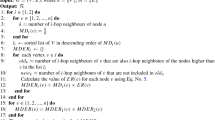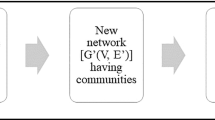Abstract
Influence maximization is currently a most extensively researched topic in social network analysis. Existing approaches tackle this task by either pursuing the real influence strength of a node or designing proper measurements for estimating it. The degree is a popularly adopted influence strength metric, based on which a variety of methods have been developed. Though with good efficiency, degree-based methods suffer unsatisfactory accuracy since this metric only covers a limited considered scale over the whole network of interest and also lacks discriminatory power. In this paper, we propose a novel influence maximization method, named Fixed Neighbour Scale (FNS), which extracts useful information from multiple levels of neighbours for a target node to estimate its influence strength, rather than only considering directly connected neighbours as in degree-based methods. To facilitate the implementation of FNS, we also present a centrality measurement termed FNS-dist, which estimates a node’s influence strength by summing its multi-level neighbours’ weights that are mainly determined by their distances to the target node. Experiments conducted on nine networks of different sizes and categories show that the proposed FNS method achieves excellent and stable performance compared with other algorithms based on designing metrics for measuring influence strength. We also exhibit that FNS-dist is a superior alternative centrality which is more proper and precise than the degree.




Similar content being viewed by others
Explore related subjects
Discover the latest articles, news and stories from top researchers in related subjects.Notes
In a nutshell, the distance between a node and its ith-level neighbours is equal to i.
References
Arora A, Galhotra S, Ranu S (2017) Debunking the myths of influence maximization: an in-depth benchmarking study. In: Proceedings of the 2017 ACM international conference on management of data, pp 651–666. ACM
Bavelas A (1950) Communication patterns in task-oriented groups. J Acoust Soc Am 22(6):725–730
Bonacich P, Lloyd P (2001) Eigenvector-like measures of centrality for asymmetric relations. Soc Netw 23(3):191–201
Borgs C, Brautbar M, Chayes J, Lucier B (2014) Maximizing social influence in nearly optimal time. In: Proceedings of the twenty-fifth annual ACM-SIAM symposium on discrete algorithms, pp 946–957. SIAM
Bouttier J, Di Francesco P, Guitter E (2003) Geodesic distance in planar graphs. Nucl Phys B 663(3):535–567
Cha M, Haddadi H, Benevenuto F, Gummadi KP (2010) Measuring user influence in twitter: the million follower fallacy. In: ICWSM 2010—proceedings of the 4th international AAAI conference on weblogs and social media, pp 10–17
Chen W, Wang Y, Yang S (2009) Efficient influence maximization in social networks. In: Proceedings of the 15th ACM SIGKDD international conference on Knowledge discovery and data mining, pp 199–208. ACM
Chen YC, Zhu WY, Peng WC, Lee WC, Lee SY (2014) Cim: community-based influence maximization in social networks. ACM Trans Intell Syst Technol 5(2):25
Cheng S, Shen H, Huang J, Zhang G, Cheng X (2013) Staticgreedy: solving the scalability-accuracy dilemma in influence maximization. In: Proceedings of the 22nd ACM international conference on information and knowledge management, pp 509–518. ACM
Cho E, Myers SA, Leskovec J (2011) Friendship and mobility: user movement in location-based social networks. In: Proceedings of the 17th ACM SIGKDD international conference on knowledge discovery and data mining, pp 1082–1090. ACM
Colizza V, Flammini A, Serrano MA, Vespignani A (2006) Detecting rich-club ordering in complex networks. Nat Phys 2(3):110–115
Diestel R (2000) Graph theory. Math Gaz 173(502):67–128
Domingos P, Richardson M (2001) Mining the network value of customers. In: Proceedings of the seventh ACM SIGKDD international conference on knowledge discovery and data mining, pp 57–66. ACM
Freeman LC (1977) A set of measures of centrality based on betweenness. Sociometry 40(1):35–41
Goyal A, Lu W, Lakshmanan LV (2011) Celf++: optimizing the greedy algorithm for influence maximization in social networks. In: Proceedings of the 20th international conference companion on world wide web, pp 47–48. ACM
Guimera R, Danon L, Diaz-Guilera A, Giralt F, Arenas A (2003) Self-similar community structure in a network of human interactions. Phys Rev E 68(6):065103
Huang J, Cheng XQ, Shen HW, Zhou T, Jin X (2012) Exploring social influence via posterior effect of word-of-mouth recommendations. In: Proceedings of the fifth ACM international conference on web search and data mining, pp 573–582. ACM
Hamsterster friendships network dataset—konect. http://konect.uni-koblenz.de/networks/petster-friendships-hamster (2017)
Kempe D, Kleinberg J, Tardos É (2003) Maximizing the spread of influence through a social network. In: Proceedings of the ninth ACM SIGKDD international conference on knowledge discovery and data mining, pp 137–146. ACM
Leskovec J, Kleinberg J, Faloutsos C (2007) Graph evolution: densification and shrinking diameters. ACM Trans Knowl Discov Data 1(1):2
Leskovec J, Krause A, Guestrin C, Faloutsos C, VanBriesen J, Glance N (2007) Cost-effective outbreak detection in networks. In: Proceedings of the 13th ACM SIGKDD international conference on knowledge discovery and data mining, pp 420–429. ACM
Li Y, Fan J, Wang Y, Tan KL (2018) Influence maximization on social graphs: a survey. IEEE Trans Knowl Data Eng 30(10):1852–1872
Liu D, Jing Y, Zhao J, Wang W, Song G (2017) A fast and efficient algorithm for mining top-k nodes in complex networks. Sci Rep 7:43330
Miller G (1998) WordNet: an electronic lexical database. MIT Press, Cambridge
Nemhauser GL, Wolsey LA, Fisher ML (1978) An analysis of approximations for maximizing submodular set functions-I. Math Program 14(1):265–294
Nguyen DL, Nguyen TH, Do TH, Yoo M (2017) Probability-based multi-hop diffusion method for influence maximization in social networks. Wirel Pers Commun 93(4):903–916
Ohsaka N, Akiba T, Yoshida Y, Kawarabayashi Ki (2014) Fast and accurate influence maximization on large networks with pruned Monte–Carlo simulations. In: 28th AAAI conference on artificial intelligence, pp 138–144
Page L, Brin S, Motwani R, Winograd T (1998) The pagerank citation ranking: bringing order to the web. Stanf Digit Libr Work Pap 9(1):1–14
Peng S, Zhou Y, Cao L, Yu S, Niu J, Jia W (2018) Influence analysis in social networks: a survey. J Netw Comput Appl 106:17–32
Radicchi F, Castellano C (2017) Fundamental difference between superblockers and superspreaders in networks. Phys Rev E 95(1):012318
Richardson M, Domingos P (2002) Mining knowledge-sharing sites for viral marketing. In: Proceedings of the eighth ACM SIGKDD international conference on knowledge discovery and data mining, pp 61–70. ACM
Ripeanu M, Foster I, Iamnitchi A (2002) Mapping the gnutella network: properties of large-scale peer-to-peer systems and implications for system design. In: IEEE internet computing journal
Shang J, Zhou S, Li X, Liu L, Wu H (2017) Cofim: a community-based framework for influence maximization on large-scale networks. Knowl Based Syst 117:88–100
Sheikhahmadi A, Nematbakhsh MA, Shokrollahi A (2015) Improving detection of influential nodes in complex networks. Phys A Stat Mech Appl 436:833–845
Tang Y, Shi Y, Xiao X (2015) Influence maximization in near-linear time: a martingale approach. In: Proceedings of the 2015 ACM SIGMOD international conference on management of data, pp 1539–1554. ACM
Tang Y, Xiao X, Shi Y (2014) Influence maximization: Near-optimal time complexity meets practical efficiency. In: Proceedings of the 2014 ACM SIGMOD international conference on management of data, pp 75–86. ACM
Wang X, Su Y, Zhao C, Yi D (2016) Effective identification of multiple influential spreaders by degreepunishment. Phys A Stat Mech Appl 461:238–247
Wang Y, Cong G, Song G, Xie K (2010) Community-based greedy algorithm for mining top-k influential nodes in mobile social networks. In: Proceedings of the 16th ACM SIGKDD international conference on knowledge discovery and data mining, pp 1039–1048. ACM
Watts DJ, Strogatz SH (1998) Collective dynamics of ‘small-world’ networks. Nature 393(6684):440
Zafarani R, Liu H (2009) Social computing data repository at ASU. http://socialcomputing.asu.edu/datasets/Douban
Zhou C, Zhang P, Zang W, Guo L (2015) On the upper bounds of spread for greedy algorithms in social network influence maximization. IEEE Trans Knowl Data Eng 27(10):2770–2783
Zhou S, Mondragón RJ (2004) The rich-club phenomenon in the internet topology. IEEE Commun Lett 8(3):180–182
Acknowledgements
This work was supported by the Fundamental Research Funds for the Central Universities (Grant No. 2018ZZCX14).
Author information
Authors and Affiliations
Corresponding author
Additional information
Publisher's Note
Springer Nature remains neutral with regard to jurisdictional claims in published maps and institutional affiliations.
Rights and permissions
About this article
Cite this article
Rui, X., Yang, X., Fan, J. et al. A neighbour scale fixed approach for influence maximization in social networks. Computing 102, 427–449 (2020). https://doi.org/10.1007/s00607-019-00778-5
Received:
Accepted:
Published:
Issue Date:
DOI: https://doi.org/10.1007/s00607-019-00778-5




